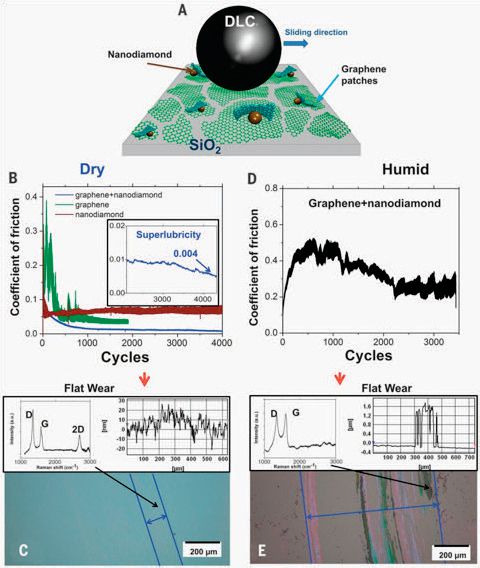Synthesizing Super-Slick Surfaces
Drs. Wilfred T. Tysoe & Nicholas D. Spencer | TLT Cutting Edge June 2016
Graphene-coated diamond nanoparticles slide against diamond-like carbon with almost zero friction.
IF A MAJOR QUEST OF TRIBOLOGY IS TO REDUCE SLIDING FRICTION, the Holy Grail is to develop so-called “superlubricious” interfaces that have vanishingly low friction coefficients.
While superlubricity has been predicted theoretically and has been achieved in carefully controlled experiments on atomically smooth and perfectly crystalline materials, it has been tantalizingly difficult to obtain at macroscopic scales. This is in part due to the fact that superlubricity relies on the presence of a mismatch between the lattice planes that slide over each other, which is lost due to the imperfections and disorder in macroscale contacts.
The Nanostructured Carbon Materials group of Dr. Anirudha Sumant, in collaboration with Surface Engineering and Tribology group of Dr. Ali Erdemir at the Argonne National Laboratory in Chicago, tried a novel approach for achieving the superlubricity at macroscale (1) by sliding graphene against a special kind of diamond-like carbon (DLC) (2, 3) in dry nitrogen.
Both materials had individually demonstrated superlubricious properties, and it was postulated that the disordered DLC surface sliding against ordered graphene flakes might produce a low shear-strength interface. However, while this interface did yield a reasonably low friction coefficient (~0.04, Fig. 1B), it was not as low as they had hoped.

Figure 1. (A) Not-to-scale schematic of the superlubricity test. (B) The COF for DLC ball sliding in a dry nitrogen environment against (i) graphene-plus-nanodiamonds (superlubricity state with COF ~ 0.004 ± 0.002), (ii) graphene alone (COF ~ 0.04 ± 0.01), and (iii) nanodiamond alone (COF ~ 0.07 ± 0.01). (Inset) A plot for superlubricity. (C) In the case of superlubricity, the wear track on the flat side is almost invisible. (Inset) A typical Raman signature of defective graphene. (D and E) For graphene-plus-nanodiamond sliding against a DLC ball in a humid environment, (D) the COF reveals a high value of ~0.27 ± 0.04, (E) the corresponding wear track on the flat side is wide, and the inset shows a Raman signature corresponding to graphitized carbon debris. The tests were performed at room temperature under 1 N load and with 3 cm/s linear speed.
Undaunted, the Argonne group came up with the idea of adding nano-sized diamond particles to the mix, arguing that if molecularly thin sheets of graphene could coat the hard diamond particles (as illustrated in Fig. 1A), they might act as tiny ball bearings, producing very low friction.
This did the trick, giving (superlubricious) friction coefficients as low as ~0.004 (Fig. 1B), with essentially no wear (Fig. 1C). The very low friction behavior proved to be remarkably robust, persisting over loads from 0.5 to 3 N, velocities from 0.6 to 25 cm/s, and temperatures from 20 to 50 C.
Molecular dynamics (MD) simulations by the group of Dr. Subramanian Sankaranarayanan, also at Argonne National Laboratory, revealed that graphene indeed encapsulates the diamond nanoparticles, thereby producing both a lack of registry between the DLC and nanoparticles as well as reducing the contact area.
Unfortunately, the group found that the superlubricious behavior was not maintained in a humid environment (at ~30% humidity) where the friction increased considerably (Fig. 1D) and was accompanied by wear (Fig. 1E). Again, MD simulations provided an answer to why this was the case. It turns out that the water adsorbs on the defect sites that lead to bonding between diamond and graphene, stopping them from bonding to each other and preventing the particles from becoming encapsulated. This shows the importance of combining results from fundamental experiments with creative insights to tailor super-low friction interfaces.
Now for the humidity problem…
REFERENCES
1. Berman, D., Desmukh, S.A., Sankaranarayanan, S.K.S., Erdemir, A., and Sumant, A.V. (2015), “Macroscale superlubricity enabled by graphene nanoscroll formation.” Science, 348, pp. 1118–1122.
2. Erdemir, A., Eryilmaz, O. L., and Fenske, G. (2000), “Synthesis of diamond-like carbon films with superlow friction and wear properties.” Journal of Vacuum Science & Technology, A18, pp. 1987-1992.
3. Gao, F., Erdemir, A., and Tysoe, W.T. (2005), “The tribological properties of low-friction hydrogenated diamond-like carbon measured in ultrahigh vacuum.” Tribology Letters, 20, pp. 221-227.

Eddy Tysoe (left) is a Distinguished Professor of Physical Chemistry at the University of Wisconsin-Milwaukee. You can reach him at wtt@uwm.edu. Nic Spencer (right) is professor of surface science and technology at the ETH Zurich, Switzerland. You can reach him at nspencer@ethz.ch. Both serve as editors-in-chief of STLE-affiliated Tribology Letters journal.